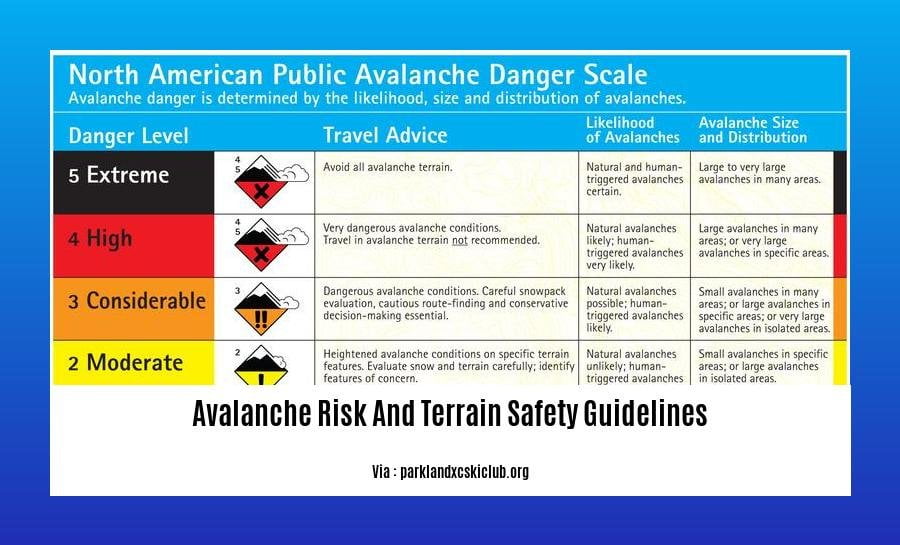As the thrill of mountaineering beckons, it’s imperative to prioritize safety. Our comprehensive guide, “Avalanche Risk and Terrain Safety Guidelines for Mountaineers,” equips you with knowledge on recognizing red flags, deciphering avalanche forecasts, mastering safety classes, and carrying essential gear. Join us as we explore these crucial elements, empowering you to navigate the mountains with confidence and mitigate the risks associated with avalanches.
Key Takeaways:

- Avalanche-prone slopes: Typically 30-45 degrees, but can occur from 25-60 degrees.
- Risky aspects: North, east, and northeast slopes tend to have higher avalanche risk.
- Common triggers: Snowstorms, wind loading, rain, human activities (e.g., skiing, snowboarding).
- Identifying avalanche terrain: Observe slope angle, snow type, elevation, aspect, and weather.
- Controlling risk: Choose safe slopes, dig snow pits to assess stability, carry safety gear (beacon, probe, shovel).
- Be aware: Avalanches can travel at high speeds and be deadly, even small ones.
- Use avalanche forecasts: While valuable, they are not always reliable.
Avalanche Risk and Terrain Safety Guidelines
Avalanches are a serious hazard for mountaineers, but they can be avoided by following a few simple guidelines.
Terrain Assessment
- Slope angle: Slopes between 30 and 45 degrees are most avalanche-prone.
- Aspect: North-facing slopes accumulate more snow and have a higher risk of avalanches.
- Triggers: Avalanches can be triggered by natural factors like snowstorms and wind, as well as human activities like skiing and snowmobiling.
Hazard Management
- Choose safe slopes: Avoid areas with potential triggers and stick to slopes with a consistent pitch and few breaks in the snowpack.
- Assess snowpack stability: Dig snow pits to check the layers of the snowpack and identify any weak layers that could lead to an avalanche.
- Carry safety gear: Always bring a beacon, probe, and shovel in case of an avalanche.
Additional Points
- Avalanches can travel up to 70 mph and bury people or buildings.
- Even small avalanches can cause serious injuries or death.
- Avalanche forecasting is helpful, but it’s not always reliable.
By following these guidelines, mountaineers can significantly reduce their risk of being caught in an avalanche.
- For more information about the avalanche danger scale and forecast, click here.
- Don’t forget to brush up on your knowledge of avalanche transceiver and rescue gear recommendations.
- It’s equally crucial to be aware of tree well and snow immersion risks.
Take an Avalanche Safety Class
Avalanches are a serious hazard for mountaineers, but they can be avoided by taking proper precautions. One of the most important things you can do is to take an avalanche safety class. These classes will teach you how to:
- Recognize avalanche terrain
- Evaluate snow stability
- Plan safe routes
- Use avalanche safety gear
- Perform a companion rescue
Key Takeaways:
- Avalanches can occur on any slope, but they are most common on slopes between 30 and 45 degrees.
- Avalanches are triggered by a variety of factors, including snowstorms, wind loading, and human activity.
- The most common type of avalanche is the slab avalanche, which occurs when a layer of snow slides over a weaker layer below.
- Avalanches can travel at speeds of up to 70 mph and can bury people or buildings.
- Even small avalanches can cause serious injuries or death.
Taking an avalanche safety class is the best way to learn how to avoid avalanches and stay safe in the mountains.
Citation:
- “Avalanche Safety.” National Snow and Ice Data Center, 2023, https://nsidc.org/cryosphere/snow/safety/avalanches.html.
Carry Avalanche Safety Gear and Know How to Use It
Backcountry enthusiasts, let’s talk about the critical importance of carrying avalanche safety gear and knowing how to use it. Avalanches are a serious hazard in mountainous regions, and being prepared can make all the difference in an emergency.
Key Takeaways:
- Carry the avalanche essentials: Shovel, beacon, and probe.
- Know how to use your gear: Practice using them before venturing into avalanche terrain.
- Consider an avalanche airbag: They can significantly increase your chances of survival.
- Stay informed about avalanche conditions: Check forecasts and avalanche bulletins before heading out.
- Avoid avalanche terrain: When possible, stay away from steep, snow-covered slopes with potential triggers.
Essential Avalanche Safety Gear
- Avalanche Shovel: A lightweight, durable shovel designed to dig out buried victims.
- Avalanche Beacon: A device that transmits a signal to help rescuers locate victims.
- Avalanche Probe: Collapsible poles used to pinpoint the location of buried victims.
Recommended Gear: Avalanche Airbag
Avalanche airbags are highly recommended in addition to the essentials. When deployed, they inflate a large balloon around the user, increasing buoyancy and reducing the risk of being buried.
Practice Using Your Gear
Just like any emergency equipment, knowing how to use your avalanche safety gear is crucial. Practice deploying your beacon and using your probe to locate buried objects. Familiarize yourself with the controls and operation of your shovel.
Stay Informed and Make Wise Decisions
Before hitting the backcountry, check avalanche forecasts and bulletins for the area you plan to visit. These reports provide valuable information about current avalanche hazard levels and recent avalanche activity. Use this information to make informed decisions about route selection and terrain avoidance.
Remember:
Your safety is your responsibility. By carrying the right gear, knowing how to use it, and staying informed about avalanche conditions, you can significantly reduce your risk of involvement in an avalanche. Respect the mountains, and enjoy your adventures safely.
Citation:
- REI: Avalanche Basics











